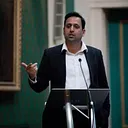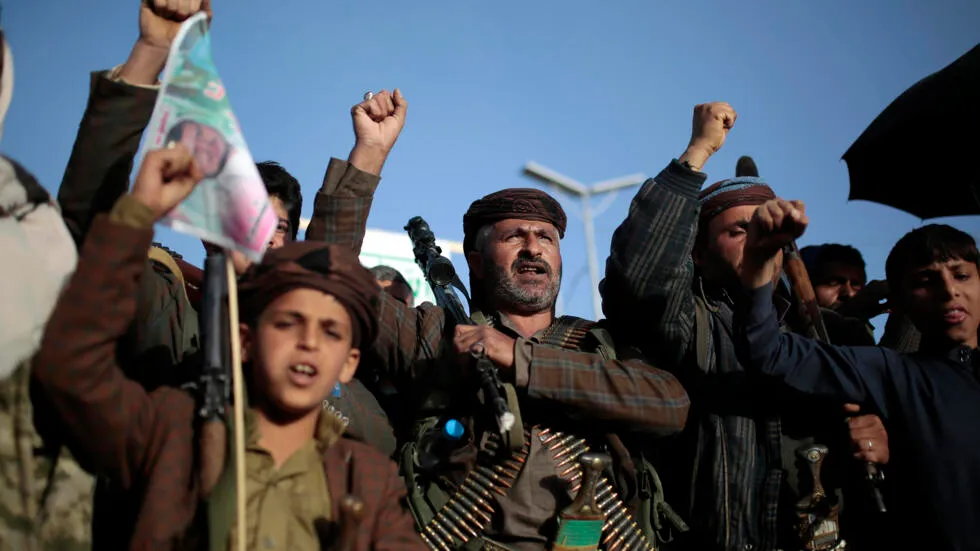Who Are the Houthis and What Do They Want?
MIDDLE EAST AND NORTH AFRICA, 29 Jan 2024
Ghaffar Hussain – TRANSCEND Media Service
15 Jan 2024 – A few weeks after Israel’s military intervention in the Gaza strip, following the events of October the 7th 2023, the Iranian-backed Houthi rebels in Yemen began attacking commercial ships in the Red Sea, ostensibly in solidarity with Hamas. They also falsely claimed that the ships were linked to Israel, when in fact the vast majority are not. 15% of global trade passes through the Bab al-Mandab strait, which is a critical waterway that sits in the Red Sea between Yemen and Djibouti. This waterway is only 20 km wide at its narrowest point and, as such, is a global chokepoint. These attacks, if allowed to continue, could cause significance disruption to world trade and lead to a sharp hike in fuel prices. Especially, since the Panama Canal is currently struggling with a drought that has led to a restriction in cargo ships passing through it.
On the 12th of Jan 2024, after issuing a series of warnings to the Houthis, a coalition that involves a number of western nations, such as the US and UK, launched air strikes on rebel targets in Yemen. However, it seems the Houthis have not been deterred at all, in fact they have only stepped up attacks ever since. They are confident in the knowledge that any military action would take time to have an impact and the disruption to global trade in the meantime would be too high a price to pay. It is widely believed that the Houthis are an Iranian proxy and leaders in Tehran hope these attacks can force a ceasefire in Gaza, which would allow for continued Hamas rule and an opportunity to re-build the military capabilities of this crucial ally.
Hamas acts as a strategic ace card that Iran plays when they feel the need to instrumentalise Muslim/Arab sympathies with the Palestinian cause for their own geo-political goals. In this instance, inflamed tensions in the region are useful to Tehran since they can jeopardise the Abraham Accords, which seek to normalise relations between Israel, Bahrain, the UAE and others. They can also thwart, or at least delay, the normalisation of ties between Saudi and Israel, which also has the effect of endangering the UAE to Israel transport corridor that circumnavigates the Red Sea and creates strategic dependence between Gulf Arab States and Israel.
The Houthis are, thus, a vital piece on the chess board that Iran needs in order to re-shape the Middle East in accordance with its own interests. But who are the Houthis, where did they come from and what do they want?
Those commonly described as Houthi rebels in the international press are actually members of a Shia Islamist group called Ansar Allah (Supporters of God). This group has always maintained an international and regional focus given their motto is “God Is Great, Death to America, Death to Israel, Curse on the Jews, Victory to Islam“. In their view, Israel and many of the Sunni leaders in the region, are American puppets that are being used to oppress Muslims. They are very similar to those who govern in Iran in this regard, except they do not necessarily endorse the Wilayat al-Faqih model, in which all political and religious matters are deferred to a religious clergy. Rather they have a pragmatic approach to politics and are not adverse to elections and sharing power with Sunnis.
The Houthis are a Yemeni tribe that primarily belong to a sub-sect of Shia Islam called Zaydism, which is named after Zayd ibn Ali, a descendent of the Prophet Muhammad who led an unsuccessful uprising against the Umayyad Empire in 740 AD. Currently, around 35% of Yemen belongs to the Zaydi sect, with the vast majority belonging to the Houthi tribe, and they dominate the north and eastern parts of the country. Politically, Northern Yemen was governed by a Zaydi Imamate (clerical rulers) for around 1000 years until an Egyptian-backed republican revolution began in 1962.
In 1990, after many years of division and civil strife, in which the country split into two and fought numerous wars, modern Yemen was born and Abdullah al-Saleh was appointed as President. This was shortly followed the emergence of a Zaydi umbrella group that sought, ostensibly, to promote and protect the interests of their ethnic/religious group. The Zaydis claimed that they were being excluded from power and persecuted for their beliefs by corrupt Sunni leaders, who were backed by the US and Saudi Arabia. This persecution only increased with the introduction of Saudi-sponsored Salafism, which was inherently sectarian and anti-Shia and entered the country from the mid-1990s onwards. From the Saudi perspective, allowing a Shia and Iranian ally to take power below its southern border would be a geo-strategic blunder.
In 2004, the Houthi leader, Hussain al-Houthi was killed after he launched a rebellion against the Yemeni government. He was soon replaced by his brother, Abdul Malik al-Houthi, who continued the rebellion which, subsequently, led to a full-scale military campaign against the rebels that was heavily supported by Saudi Arabia. The Arab Spring protests of 2011 gave great impetus to the Houthi rebellion since the country became unstable and security broke down. Widespread protests against President Saleh, who was now widely perceived as corrupt and ineffective, allowed a power vacuum to emerge. Within a short space of time the Houthis were able to take large swathes of territory in the country and emerge as a capable military force.
By 2014, the Houthis had become a dominant political force in the country, taking numerous strategic provinces as well as the capital Sanaa. This resulted in a Saudi-led intervention in support of the struggling government led by Abdrabbuh Mansur Hadi, who replaced Saleh in 2012. The Saudi backed military campaign included air strikes, a naval blockade and ground forces as well as logistical support from the US and UK. This campaign was widely criticised for worsening the humanitarian situation in Yemen and for not achieving its goals, despite the military and technological superiority of the forces fighting the Houthis. Saleh himself was killed in 2017 after he broke off ties with the Houthis, who he briefly allied with after being ousted from power.
By March 2022, the Saudi backed campaign had ran out of steam and came to an end. The two belligerents had reached a stalemate, which effectively signalled a Houthi victory given they were the ones holding onto and defending contested territory. Knowledge of home turf, and the mountainous terrain of Northern Yemen, combined with insurgency experience and technological support from Iran, in the form of drones and missiles, has given the Houthis an edge over more advanced external powers. A lack of unity amongst their opponents within Yemen also means that they are unlikely to be dislodged any time soon.
It is not clear when exactly Iran began to support the Houthis but we know that the leaders in Tehran began making their support known publicly by 2012. What is clear is the fact that they have emerged as a major strategic ally for Iran in recent years given their proximity to the old adversary Saudi Arabia and the Red Sea. However, it would be wrong to describe them as an Iranian puppet in the way Hezbollah has become, at least not for now. They clearly enjoy a close working relationship and that has suited both parties very well. The extent to which the Houthis can govern and control Yemen in the next few years will shape the nature of their relationship with Iran. Too much power would mean they are more likely to chart their own course, conversely too little power would mean they are not useful to Tehran.
From a western perspective, the bombing campaign is unlikely to act as deterrent for a group that has endured and survived years of aerial bombardment. The Houthis are now a competent and effective fighting force backed by Iran, which, in turn, has support from Russia and other regional allies in Lebanon and Syria. They have fighters, weapons, cheap energy supplies from allies and are aware that regional adversaries, such as the Saudis and UAE, have limited appetite for more war. Like the Taliban in Afghanistan, what the Houthis really seek is recognition. By flexing their muscle in the Red Sea, they gain instant support and sympathy in the region and demonstrate to the rest of the world that they are the dominant political and military force in Yemen.
The Middle East is changing fast, new alliances are forming and old certainties are being tested. Power is shifting away from western allies and Yemen, like Iraq, Lebanon and Syria, is now moving into the Tehran-Moscow orbit of influence. Military strikes may seem like the only and obvious response from a western perspective but it seems our leaders have not been keeping up with developments in this most troubled of neighbourhoods.
______________________________________
 Ghaffar Hussain: Community Resilience Manager – London Borough of Newham. MA in Politics, BSc in Psychology. Subject matter expertise – radicalisation trends, geo-politics and online harms.
Ghaffar Hussain: Community Resilience Manager – London Borough of Newham. MA in Politics, BSc in Psychology. Subject matter expertise – radicalisation trends, geo-politics and online harms.
Go to Original – ghaffar.substack.com
Tags: Houthi, Iran, Iraq, Lebanon, Middle East, Russia, Saudi Arabia, Syria, Yemen
DISCLAIMER: The statements, views and opinions expressed in pieces republished here are solely those of the authors and do not necessarily represent those of TMS. In accordance with title 17 U.S.C. section 107, this material is distributed without profit to those who have expressed a prior interest in receiving the included information for research and educational purposes. TMS has no affiliation whatsoever with the originator of this article nor is TMS endorsed or sponsored by the originator. “GO TO ORIGINAL” links are provided as a convenience to our readers and allow for verification of authenticity. However, as originating pages are often updated by their originating host sites, the versions posted may not match the versions our readers view when clicking the “GO TO ORIGINAL” links. This site contains copyrighted material the use of which has not always been specifically authorized by the copyright owner. We are making such material available in our efforts to advance understanding of environmental, political, human rights, economic, democracy, scientific, and social justice issues, etc. We believe this constitutes a ‘fair use’ of any such copyrighted material as provided for in section 107 of the US Copyright Law. In accordance with Title 17 U.S.C. Section 107, the material on this site is distributed without profit to those who have expressed a prior interest in receiving the included information for research and educational purposes. For more information go to: http://www.law.cornell.edu/uscode/17/107.shtml. If you wish to use copyrighted material from this site for purposes of your own that go beyond ‘fair use’, you must obtain permission from the copyright owner.
Read more
Click here to go to the current weekly digest or pick another article:
MIDDLE EAST AND NORTH AFRICA:
